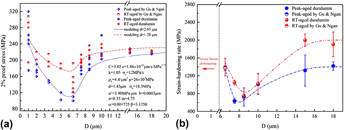Crossref Citations
This article has been cited by the following publications. This list is generated based on data provided by
Crossref.
Yan, Shaohua
Zhou, Haiyang
Xing, Bobin
Zhang, Shuang
Li, Li
and
Qin, Qing H.
2018.
Crystal plasticity in fusion zone of a hybrid laser welded Al alloys joint: From nanoscale to macroscale.
Materials & Design,
Vol. 160,
Issue. ,
p.
313.
Gan, K.F.
and
Ngan, A.H.W.
2018.
The unusual size effect of eutectic Sn/Pb alloys in the micro regime: Experiments and modeling.
Acta Materialia,
Vol. 151,
Issue. ,
p.
282.
Pan, Yan
Wu, Haijun
Wang, Xiaofei
Sun, Qiaoyan
Xiao, Lin
Ding, Xiangdong
Sun, Jun
and
Salje, Ekhard K. H.
2019.
Rotatable precipitates change the scale-free to scale dependent statistics in compressed Ti nano-pillars.
Scientific Reports,
Vol. 9,
Issue. 1,
Pan, Yan
Sun, Qiaoyan
Xiao, Lin
Ding, Xiangdong
and
Sun, Jun
2019.
Plastic deformation behavior and microscopic mechanism of metastable Ti-10V-2Fe-3Al alloy single crystal pillars orientated to <011>β in submicron scales Part I: Double size effects and martensitic transformation prediction.
Materials Science and Engineering: A,
Vol. 743,
Issue. ,
p.
798.
Yan, Shaohua
Zhou, Haiyang
and
Qin, Qing H.
2019.
Microstructure versus size: nano/microscale deformation of solute-strengthening Al alloys via pillar compression tests.
Materials Research Letters,
Vol. 7,
Issue. 2,
p.
53.
Li, Xiaohua
Liu, Yongchang
Gan, Kefu
Dong, Ji
and
Liu, Chenxi
2020.
Acquiring a low yield ratio well synchronized with enhanced strength of HSLA pipeline steels through adjusting multiple-phase microstructures.
Materials Science and Engineering: A,
Vol. 785,
Issue. ,
p.
139350.
Gan, Kefu
Zhu, Shuya
Jiang, Songshan
and
Huang, Yongjiang
2020.
Study on stochastic nature of plasticity of Cu/Zr metallic glass micropillars.
Journal of Alloys and Compounds,
Vol. 831,
Issue. ,
p.
154719.
Li, Xiaohua
Shi, Lei
Liu, Yongchang
Gan, Kefu
and
Liu, Chenxi
2020.
Achieving a desirable combination of mechanical properties in HSLA steel through step quenching.
Materials Science and Engineering: A,
Vol. 772,
Issue. ,
p.
138683.
Gan, Kefu
Yan, Dingshun
Zhu, Shuya
and
Li, Zhiming
2021.
Interstitial effects on the incipient plasticity and dislocation behavior of a metastable high-entropy alloy: Nanoindentation experiments and statistical modeling.
Acta Materialia,
Vol. 206,
Issue. ,
p.
116633.
Zeng, Quanqing
Gan, Kefu
and
Wang, Yin
2021.
Effect of Heat Treatment on Microstructures and Mechanical Behaviors of 316L Stainless Steels Synthesized by Selective Laser Melting.
Journal of Materials Engineering and Performance,
Vol. 30,
Issue. 1,
p.
409.
Chen, Wufan
Wang, Xiaoyuan
Yan, Yabin
Sumigawa, Takashi
Kitamura, Takayuki
Feng, Miaolin
and
Xuan, Fu-Zhen
2021.
Bending stress relaxation of microscale single-crystal copper at room temperature: An in situ SEM study.
European Journal of Mechanics - A/Solids,
Vol. 90,
Issue. ,
p.
104377.
Liu, Ying
Liu, Wenbin
Yu, Long
Sui, Haonan
Cheng, Yangyang
and
Duan, Huiling
2022.
Size-dependent to size-independent transition in creep of single crystalline Cu micropillars.
Extreme Mechanics Letters,
Vol. 56,
Issue. ,
p.
101843.
Wan, H.Y.
Yang, W.K.
Wang, L.Y.
Zhou, Z.J.
Li, C.P.
Chen, G.F.
Lei, L.M.
and
Zhang, G.P.
2022.
Toward qualification of additively manufactured metal parts: Tensile and fatigue properties of selective laser melted Inconel 718 evaluated using miniature specimens.
Journal of Materials Science & Technology,
Vol. 97,
Issue. ,
p.
239.
Huang, Weiying
Zhang, Wen
Yu, Qiang
Wu, Pengfei
Tong, Yonggang
and
Gan, Kefu
2024.
A promising strategy of multicomponent alloy intermedium for enhancing the mechanical performance of inertia friction welding joints of Inconel 718 alloys.
Materials Science and Engineering: A,
Vol. 899,
Issue. ,
p.
146480.
Liu, W.B.
Cheng, Y.Y.
and
Duan, H.L.
2024.
Innovative Lightweight and High-Strength Alloys.
p.
213.
Huang, Weiying
Zhang, Song
Tong, Yonggang
Wu, Pengfei
and
Gan, Kefu
2024.
Exceptional creep resistance enabled by thermally stable cellular dislocation structures in an additively manufactured multicomponent alloy.
Materials Science and Engineering: A,
Vol. 890,
Issue. ,
p.
145902.




